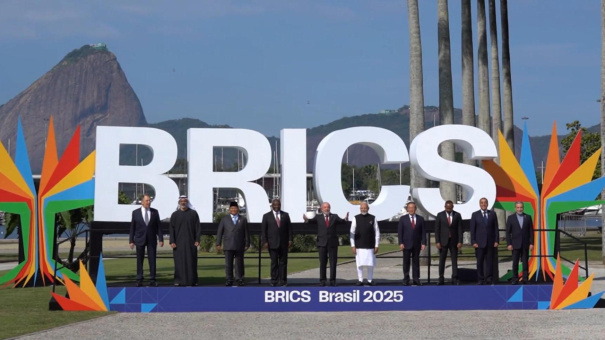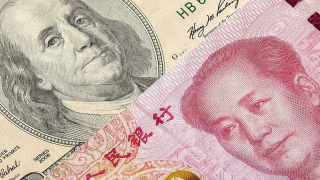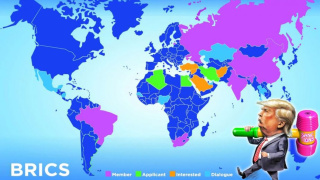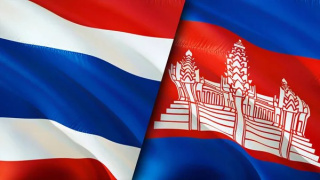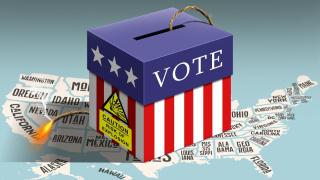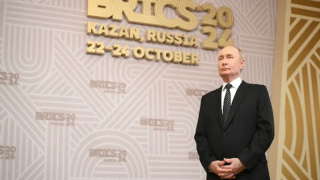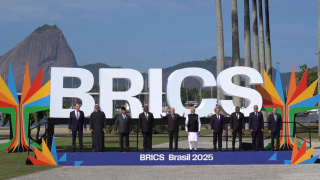BRICS Summit In Rio
BRICS’ latest annual summit took place in Rio from 6-7 July. It was the first time that its official partner states, which are known as BRICS+ and were formalized during the last BRICS Summit in Kazan last October, participated in the event. President Putin took part via video due to Brazil’s membership in the “International Criminal Court” that issued a politicized warrant for his arrest in 2023 while President Xi didn’t attend in any capacity citing scheduling issues (though some speculate that there’s more to it).
In any case, the 126 paragraph-long declaration that was agreed upon after Sunday’s plenary session encapsulates the group’s worldview, which can be summarized as prioritizing the acceleration of financial multipolarity processes so as to more effectively reform of global governance. There are climate, health, security, and other aspects to their declaration, just like there always is, but they pale in comparison to what BRICS is trying to pull off with regard to its aforementioned grand strategic goal.
As the primary means to that end, they all aim to diversify their economic and financial ties with the West in order to preemptively avert the scenario of the West weaponizing these ties for political purposes exactly as they’ve done against Cuba, Iran, Russia. This takes the form of relying more on national currencies in bilateral trade and creating complementary financial institutions and instruments. The latter include the New Development Bank (NDB) and two newly announced projects.
These are the New Investment Platform (NIP) and BRICS Multilateral Guarantees (BMG) initiative. Russian Finance Minister Anton Siluanov also said during the latest annual gathering that “The [NDB] can become BRICS' cross-border settlement hub.” Taken together, these three institutions and instruments can serve as the bedrock upon which a complementary non-Western financial order can be built, which is meant to deprive the West of the strings that it attaches to associated services to the non-West.
It'll take some time to bear fruit, but the vision is that honest lending, investments, guarantees, and the like will more effectively stimulate economic development in non-Western countries, especially the medium- and smaller-sized ones that tend to be victimized the most by the World Bank and the IMF. As they stabilize and prosper, so too will their neighbors, as the thinking goes. This can then strengthen the role of regional organizations in the global economy and thenceforth global governance.
One of the trends most closely connected with the global systemic transition to multipolarity is the growing role of regional organizations, which BRICS has recognized as proven by each year’s chair inviting countries associated with their own regional organizations or friendly ones like ASEAN. The way that the group sees it, all efforts should be made to improve the standing of regional organizations so that they can then take more responsibility for their comparatively medium- and smaller-sized members.
This division of labor, for lack of a better description, is due to the belief that countries within the same regional organizations know one another and their challenges better than any others ever could. BRICS is thus conceptualized as both a global forum for discussing these same challenges as well as a platform for helping members, partners, and third countries surmount them through assistance from the NDB, NIP, BMG, and other institutions and instruments. It therefore represents something entirely new.
Practically all regional organizations are represented in BRICS either as members or partners. Unlike the UN with its broad agenda and occasional inability to implement it due to UNSC deadlock, BRICS’ participants are more focused on accelerating financial multipolarity processes than anything else and all voluntarily agree to implement its agenda as articulated in the group’s annual declarations. This makes them a “coalition of the willing” to borrow from the Western lexicon.
Unlike Western analogues that have only ever assembled to solidify their hegemony in the case of the G7 and the coalition that the US brought together ahead of invading Iraq, to cite two of the most well-known examples, BRICS’ “coalition of the willing” is anti-hegemonic and peaceful. It’s not “anti-Western” in the sense of wanting to harm Western countries’ legitimate interests, but some Westerners perceive it otherwise due to the collective potential of its members and partners to erode Western hegemony.
Trump has infamously overreacted to BRICS on several occasions, most recently by threatening them all with 10% extra tariffs, since he either realized on his own or was led to believe by his advisors that the US’ economic growth is dependent to a large degree on lopsided trade and investment ties with others. It’s precisely this lopsidedness, in particular his weaponization of tariffs, that BRICS wants to gradually change through the means that were described till now in this analysis.
Nevertheless, as noble as these aspirations are, the group will forever remain vulnerable to the US-led West’s divide-and-rule plots given many members’ and partners’ close trade, financial, and investment ties with that bloc. From the US’ perspective, the successful implementation of BRICS’ agenda would deal a deathblow to America’s hegemonic model, which is why Trump is promulgating a dual-track policy of trying to stimulate domestically driven development in parallel with dividing-and-ruling BRICS.
His tariff war, which he previously described as an “economic revolution”, is meant to proverbially kill both birds with one stone by incentivizing businesses at home and abroad to invest in America while coercing countries (including BRICS-affiliated ones) into political concessions for lesser tariffs. Despite the group’s denials, Trump is obsessed with the scenario of them creating their own currency, which he seems to fear could be a means for secretly internationalizing the yuan at the dollar’s expense with time.
If the yuan occupied a much larger share than other members’ currencies in the basket that some proposed could form the basis of a BRICS currency, then it’s plausible that this could happen, especially if it was accepted for energy purchases and thus began to compete with the petrodollar. Russia and Iran have some of the world’s largest natural gas reserves while Russia, the UAE, and BRICS associate Saudi Arabia (its official relationship with the group remains unclear) have some of the largest oil reserves.
Therefore, it’s entirely plausible that they could form their own “coalition of the willing” within BRICS for at least allowing the yuan to be used for such purchases, even if under the cover of a BRICS currency one day wherein the yuan occupies a greater role than any other currency. Other arrangements for different but nonetheless complementary efforts for accelerating financial multipolarity processes are also possible. The point is that intra-BRICS working groups are the key to effecting tangible change.
It's here where it’s important to remind readers that realistic expectations are crucial. The high hopes that some had of BRICS swiftly bringing about an end to the West’s financial hegemony were well-intentioned but ultimately based on the false premise that BRICS is a bloc, not a voluntary group. It’ll accordingly take time to achieve its members’ goals, especially since some of them are rivals, so well-wishers shouldn’t be disappointed if the group’s goals aren’t achieved in full anytime soon.
The Sino-Indo rivalry is BRICS’ primary fault line, but other important ones are the continued mutual mistrust between Iran and Saudi Arabia as well as the regional tensions between Egypt and Ethiopia. Moreover, members’ and partners’ demographic and economic asymmetries impede concerted action. What’s good for some of them, such as the pace and scale at which a certain shared policy is implemented, isn’t always good for others. Everyone will thus proceed as they feel comfortable.
The preceding differences do indeed facilitate the US-led West’s efforts to divide-and-rule BRICS, but observers should also remember that the political differences that were mentioned predate BRICS. This means that not every potentially forthcoming instance of tensions between members and/or partners is part of a Western plot, though such scenarios also shouldn’t be automatically ruled out either. Countries like Russia which enjoy close ties with all BRICS affiliates could potentially mediate between their peers.
Regardless of the obstacles that might emerge, the global systemic transition to multipolarity is irreversible. The general form that this will take is BRICS affiliates strengthening their national currencies, expanding trade among themselves, and collectively creating non-Western financial institutions and instruments that complement existing Western ones. There’ll also be a focus on empowering the regional organizations within which affiliates are a part in order to ultimately reform global governance.
All told, the latest BRICS Summit in Rio wasn’t a game-changer, but that’s not a bad thing. The group’s plans remain on track and continue being implemented. Try as the US-led West might, it’ll be unable to reverse multipolar trends even if they sometimes achieve tactical successes. BRICS represents an entirely new hybrid economic-political model that’s championing change across the world. Without BRICS, the global systemic transition to multipolarity would be a lot slower, but it’ll still take time to fully unfold.
